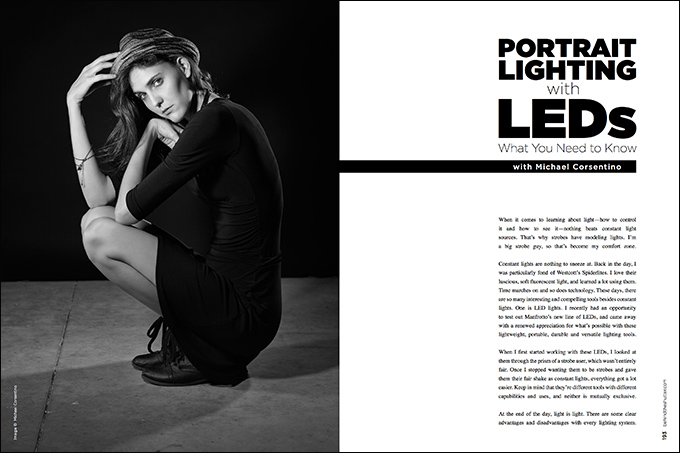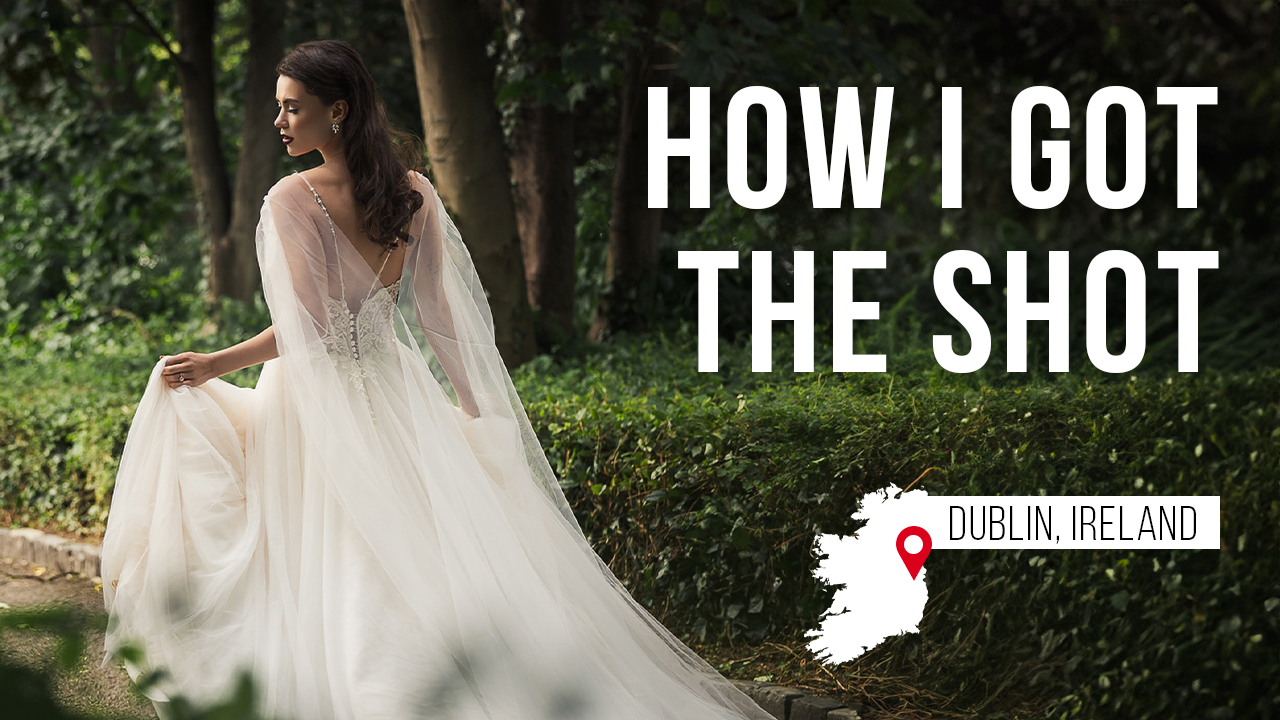Portrait Lighting with LEDs: What You Need to Know with Michael Corsentino
When it comes to learning about light—how to control it and how to see it—nothing beats constant light sources. That’s why strobes have modeling lights. I’m a big strobe guy, so that’s become my comfort zone.
Constant lights are nothing to sneeze at. Back in the day, I was particularly fond of Westcott’s Spiderlites. I love their luscious, soft fluorescent light, and learned a lot using them. Time marches on and so does technology. These days, there are so many interesting and compelling tools besides constant lights. One is LED lights. I recently had an opportunity to test out Manfrotto’s new line of LEDs, and came away with a renewed appreciation for what’s possible with these lightweight, portable, durable and versatile lighting tools.
When I first started working with these LEDs, I looked at them through the prism of a strobe user, which wasn’t entirely fair. Once I stopped wanting them to be strobes and gave them their fair shake as constant lights, everything got a lot easier. Keep in mind that they’re different tools with different capabilities and uses, and neither is mutually exclusive.
At the end of the day, light is light. There are some clear advantages and disadvantages with every lighting system.
Benefits of Constant Light
I call constant light “what you see is what you get” lighting. Because the light source is always on, unlike flash, seeing exactly what you’re getting with your lighting couldn’t be simpler. Constant lights are great for anyone who wants to learn lighting. Compared to flash, constant lights are also considerably less distracting and invasive—there’s no jarring flash popping every other minute. This makes them perfect for use with newborns, children, pets and anyone unaccustomed to being professionally lit and photographed.
With constant lights, people basically forget that they’re being lit. This results in much more relaxed subjects and images. Many constant-light systems are also cool to the touch, another advantage when working with toddlers and children. There are also times you may want to combine constant lights and strobes for some really fun and creative effects with gels. Since there’s virtually no heat, LEDs work particularly well for this.
One technique involves using a strobe to freeze the action and a constant light source such as an LED to introduce color and motion. This is achieved by using a slower shutter speed, aka “dragging the shutter,” to capture the constant light source motion and color. Try this technique out sometime, I’m sure you’ll love it. Suffice it say to say, when it comes to gels, LEDs provide a lot of flexibility technically and creatively.
Disadvantages of Constant Light
There are no 100-percent-perfect solutions. Constant lights in general don’t have as much power as strobes. However, as ISO ratings continue to climb and performance continues to improve, this is becoming less and less of an issue.
Constant lights aren’t going to be your first choice for freezing action. This is better left to strobes, hands down. The way constant lights interact with the human eye is also a stumbling block for some people. Since they are always on, constant lights give the iris time to adjust to the light and therefore contract. Some find these smaller irises objectionable. This has never really bothered me that much. Another thing to keep in kind is the reduced range of light modifiers you’ll have at your disposal. For me, the benefits outweigh any negatives.
Why LEDs?
There are numerous constant light systems to choose from: tungsten, HMI, fluorescent and LED, to name a few. Each has its own pluses and minuses, running the gamut from pricing to features to benefits. So why choose LED? Again, what you see is what you get, and they differ from other constant light sources in some important ways. They have no internal filament like a traditional lightbulb. This makes them extremely durable. They rely solely on the movement of electrons housed in a semiconductor material. This makes them more efficient, durable, versatile, and longer lasting than the average bulb. LEDs are energy efficient, typically requiring only 30 to 60 milliwatts to operate. They are shockproof, providing considerably more durability compared to filament-based lamps. Their lower power consumption makes them the perfect fit for battery operation, and many are available with optional battery capabilities.
The lower power output of LED lights and their lack of heat makes them the prefect tool to use when working with plastic gels. Gels work counterintuitively, and one might assume that the more light you put through a gel the bigger the effect or the higher the intensity of the color produced. Actually, exactly the opposite is true. Gels work best with less light. I know this is a strange concept to grasp, but trust me, the less light you use with gels, the more saturated the colors you get.
Final Impressions
After working with LEDs on several test projects, my impressions are as follows. Every light source has certain characteristics and qualities. LEDs have a particularly quick light fall-off “envelope.” This means the farther away you place them, the less light will reach your subject. This is true of every light source, but with LEDs, it’s dramatic. They’re best used close to your subject. This works perfectly for portraits, beauty and some fashion applications, but they wouldn’t be my first choice for group shots.
Good lighting instruments are all about consistent color across their power range. With LED lights, this is indicated by their CRI rating; in this case, the higher the number, the better the consistency.
Other features worth looking for and investing in are bicolor capabilities. Bicolor LED lights allow you to dial in either daylight or tungsten color balance. Next is Bluetooth control. The Manfrotto LEDs I’ve been working with have both of these super useful features. Bicolor gives you twice the utility for each fixture, and Bluetooth allows you to control the LED lights remotely from any iOS device, which is pretty sweet. Bicolor operation is another one of those features that distinguishes LEDs from other constant light sources and strobes.
With the convergence of still and video, having a few LED lights in your kit is a good long-term investment. They can do double duty for both still and video, and they offer a great way to learn lighting.




